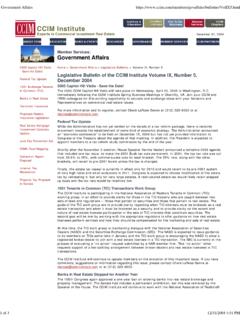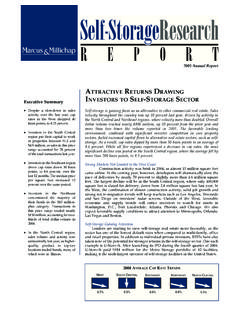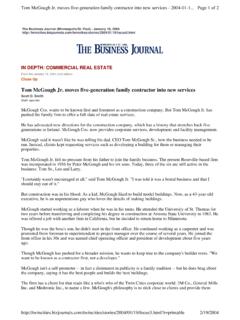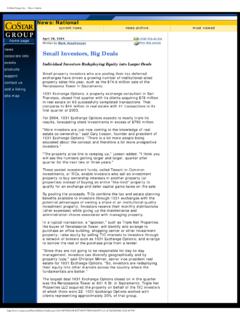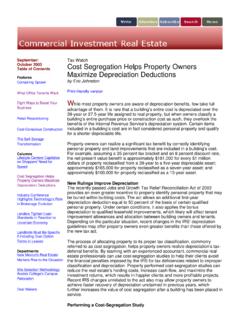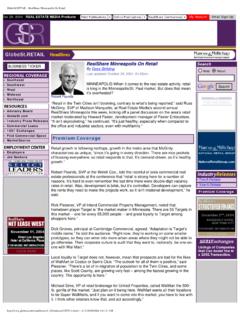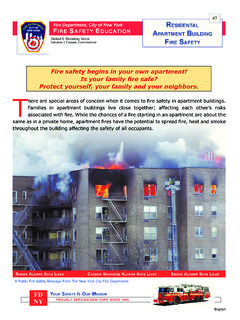Transcription of NAR 2005 FINAL - Upland
1 NATIONAL RESEARCH REPORTAPARTMENTAPARTMENT2005 ANNUAL REPORTH arvey E. GreenHessam NadjiPresident and Managing DirectorChief Executive OfficerResearch Services To our valued clients:Recent economic indicators suggest that employment growth will finally accelerate to levels that willgenerate meaningful demand for rental units. After two years of healthy advance, gross domesticproduct (GDP) is expected to cool off somewhat to a still respectable rate of percent in 2005. Inaddition, corporate balance sheets are strong, business investment has returned, inflation remainstame and oil prices have come off their recent the Fed s short-term interest rate increases, long-term rates remain low, reflecting investorcaution and the effects of offshore capital flows into Treasuries.
2 Our Asian trading partnerscontinue to limit currency devaluation, which has become a major concern for many economists. Theballooning deficit, in addition to any major and/or sudden shifts in currency dynamics, posessignificant risks to interest rates. This is one piece of the broader puzzle of increased volatilityand geopolitical risk that will be with us for some time. Meanwhile, real estate capital flows, particularly for apartments, continue to dominate the investmentlandscape and will do so again in 2005. Most evidence points to continuation of the economicexpansion cycle, which will further attract real estate capital. We expect the yield on the 10-yearTreasury to rise 100 to 150 basis points, still low by historical norms.
3 The higher cost of capital willcause somewhat of a market shift, but the need for low-risk cash flow will dominate the investmentstrategy of private investors, who are largely aging baby boomers, institutional investors andadvisors, as well as REITs. This macro trend, coupled with the durability of the expansion cycle andemerging echo-boom generation, bodes well for apartment investments. That is not to say that investors should count on status quo. Some of the most active apartmentmarkets registered moderating investment activity and a slowdown in price appreciation as of the same time, markets that lagged the recovery are getting more attention. Expect these marketvariations to continue in 2005. An increasing volume of capital from strong markets will move tocontrarian markets that offer higher yields, value-add transactions and alternative property apartment owners are pursuing property types that offer an attractive cap rate spread and/orless intensive management.
4 Office and single-tenant net-lease properties, in particular, will continueto gain favor as a improvement in apartment market fundamentals will be moderate, we are at least headed inthe right direction. Rising mortgage rates will have a positive effect on renter demand, butimprovement in vacancy will be hindered by new supply. Rent growth is forecast to remain somewhatmoderate, but will be accompanied by easing concessions, which have cut deeply into NOIs inrecent assist you in planning and executing a successful strategy, we are pleased to present our 2005 National apartment Report. We hope you benefit from this tool and the expertise of our apartmentinvestment specialists across the nation. We look forward to being a part of your ,2005 Annual ReportNATIONAL PERSPECTIVEE xecutive Summary.
5 3 National apartment Index .. 4 National Economy .. 6 Capital Markets .. 7 apartment Overview .. 8 Investment Outlook .. 9 MARKET OVERVIEWSA tlanta .. 10 Austin .. 11 Boston .. 12 Charlotte .. 13 Chicago .. 14 Cincinnati .. 15 Cleveland .. 16 Columbus .. 17 Dallas-Fort Worth .. 18 Denver .. 19 Detroit .. 20 Fort Lauderdale .. 21 Houston .. 22 Indianapolis .. 23 Jacksonville .. 24 Las Vegas .. 25 Los Angeles .. 26 Miami .. 27 Milwaukee .. 28 Minneapolis-St. Paul .. 29 Statistical Summary Table ..30-31 New Haven .. 32 NYC-Manhattan .. 33 Northern New Jersey .. 34 Oakland .. 35 Orange County .. 36 Orlando .. 37 Philadelphia .. 38 Phoenix .. 39 Portland .. 40 Raleigh-Durham.
6 41 Riverside-San Bernardino .. 42 Sacramento .. 43 Salt Lake City .. 44 San Antonio ..45 San Diego .. 46 San Francisco .. 47 San Jose .. 48 Seattle .. 49 Tampa .. 50 Tucson .. 51 Washington, .. 52 West Palm Beach .. 53 CLIENT SERVICESN ational Multi Housing Group (NMHG) .. 54 Research Services .. 55 Marcus & Millichap Capital Corporation .. 56 Contacts, Sources and Definitions .. 57 Office Locations .. 58 Written by Erica Linn, National Research Manager, James H. Holt, National Client Services Manager and edited by Hessam Nadji, Managing Director. TheCapital Markets section was co-authored by William E. Hughes, Senior Vice President, Marcus & Millichap Capital Corporation. Additional contributionswere made by Marcus & Millichap market analysts and investment brokerage professionals Annual Reportpage 3 National apartment Supply/Demand Index Four of the top five markets are in Southern California, with Riverside-San Bernardino taking the top spot.
7 Las Vegas broke into the top five thanks to a nation-leading job growth forecast, below-average vacancy rateand rising home prices. Some caution is in order, however, as for-sale single-family housing inventory hasincreased since mid-2004. If a share of these homes are placed into the rental pool, it would cut into Class Aapartment demand. Six of the bottom 10 markets are located in the Midwest. While these markets are registering improvement, theyare recovering at a slower pace than other markets in our index, which is pushing them down in the ranking. Markets with above-average concentrations of high-tech employment rose in the index, as we expect increasedbusiness investment into equipment and software to translate into jobs.
8 Austin rose two spots to #27, Portlandclimbed two places to #26, San Jose rose three spots to #22 and Seattle gained eight positions to #18. National Economy GDP growth is expected to come in at percent for 2004. Next year, we expect some cooling off, withannual growth forecast at percent. Employment growth in 2004 is estimated at percent. We expect moderate acceleration to 2 percent nextyear, which equates to million jobs, as the economic recovery gains traction. The positive effects of cashed-out equity and tax cuts are fading, which will cause a deceleration in consumerspending growth. Energy prices are trending down, however, which will relieve some of the pressure. Inflation has remained mild, ending 2004 at an estimated percent.
9 As 2005 progresses, oil prices areexpected to decline further and interest rates will rise, which is forecast to keep inflation limited to the 2 percentto 3 percent Markets At the end of 2004, spreads on high-quality assets were 90 to 110 basis points over the 10-year Treasury, whilelesser-quality properties were being underwritten at 110 to 130 basis points. Spreads could tighten further asinterest rates rise and lenders remain competitive. Default rates for multi-family loans in CMBS pools are up from 2003, with the increase attributable to loans onproperties in oversupplied markets; however, conduits are expected to remain active over the next year. The 10-year Treasury yield is forecast to rise 100 to 150 basis points in 2005, which is still low by historicalstandards.
10 Construction loan activity remains brisk. Spreads are quoted at 150 to 220 basis points over LIBOR on high-leverage deals, with low-leverage transactions commanding spreads in the 120 to 150 basis point Market Overview Vacancy registered a 20 basis point decline in 2004, to percent. Further improvement, to percent, isforecast for 2005 as demand rises in response to stronger job creation. Concessions will begin to burn off in 2005. Effective rents are forecast to rise by percent, outstripping askingrent growth by 150 basis points. Construction completions will total slightly less than 100,000 units in 2005, similar to the pace reported in 2004. Condo conversions remain popular. For now, conversions to for-sale units are offsetting new supply in manymarkets, but if the condo market slows, many of these units will likely be added to the rental pool.

